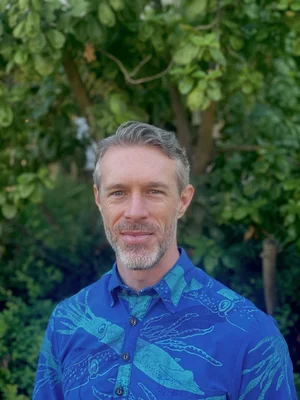
The Climate Guy

Matthew Gonser has just been named Los Angeles County’s Climate Resilience Officer, working within the Chief Sustainability Office. Moving from a similar position in Honolulu, Gonser now has been tasked to define the Climate Resilience Initiative as passed by the Board of Supervisors. He will be working with the Board and department leadership on such issues as mitigating increased heat, flooding, wildfires and other threats detailed in the County’s recent Climate Vulnerability Assessment. He holds Master’s degrees in regional planning and landscape architecture from Cornell University. Here he offers his take on how our region can best tackle climate change.
What are the biggest challenges in making metropolises more climate resilient?
Here are a few: inertia, overcoming and/or undoing past decisions and investments, and having the confidence to take actions amidst uncertainty. Changes to our climate (the direct result of burning fossil fuels) can be abstract, overwhelming, and have cascading impacts on so many elements of life, so addressing it will take lots of actions with other interdependencies. There’s no singular policy, partnership or investment that will make us climate resilient. It requires stick-to-itiveness. These are the questions we need to be asking: What can we no longer afford to do anymore and what must we figure out how to afford to do? That’s no small task for any jurisdiction of any size. For a region of our size with such local and national importance, it’s a real leadership opportunity.
It’s sometimes easy to be fatalistic or overwhelmed by impending climate change. How do we avoid a doom and gloom mentality about it?
As with many problems, the antidote to despair is action and supportive networks. Climate resilience work is community work. We are not (and can’t be) just preparing for the worst. In addressing the things that communities care about — clean air, safe and reliable water, thriving communities that are connected and affordable — we are also tackling climate challenges. When we’re successful in redressing structural harms and rethinking past conventional wisdom about community design and infrastructure, we’ll also be successful in taking climate action. Being in this line of work in government, the private sector, or at the community level certainly can be overwhelming and disheartening at times. But I’m personally motivated and engaged by the pride and perseverance that I see in other individuals and groups doing this hard work.
You are focused on overarching policy, but what are some steps you’d like to see residents take in their everyday lives to help the County achieve its climate goals?
Talk about sustainability and climate with family members and friends. Try out new things that may ultimately become habits. Environmental or community experience is key to critiquing what isn’t serving us best and generating ideas for improvements/solutions. This could be anything from expanding your transit choices -- even biking, walking or taking the bus or train once a week; challenging each other around water or energy conservation; assessing and addressing in-home food or other waste generation; or volunteering to help stewardship or restoration efforts in your area.
How does one do that?
I’m new here, so I’m looking forward to getting out and getting connected with neighbors and community leaders, too! There are also many podcasts available covering all sorts of climate topics, questions and solutions to ease concerns and motivate toward action. All that said, climate resilience also does not rest as the responsibility of individuals. Notions of personal impact and consumer choices are limiting and, at times, victim blaming. There are essential structural and institutional issues that need to be addressed at many scales for our collective climate security.
What are 3 things you are most looking to doing in L.A. in your free time …
Eating, riding bikes and transit, and learning about new plants and animals!